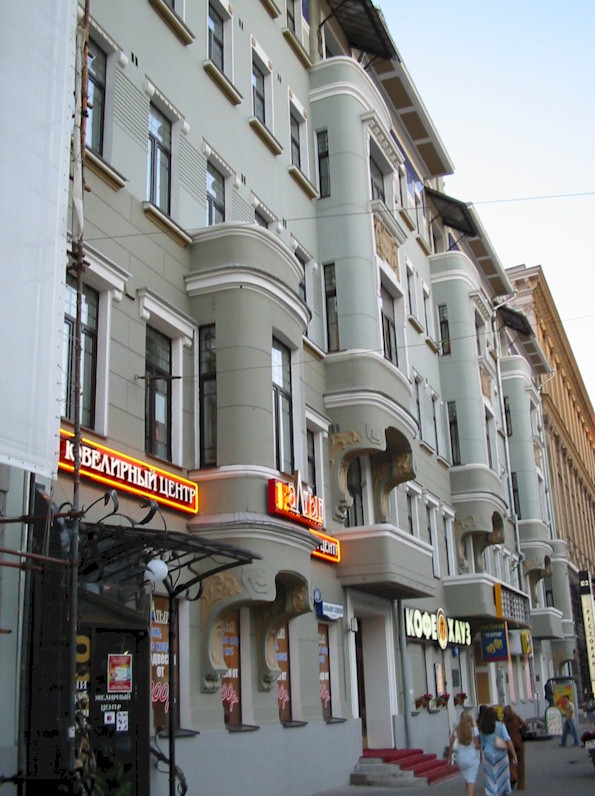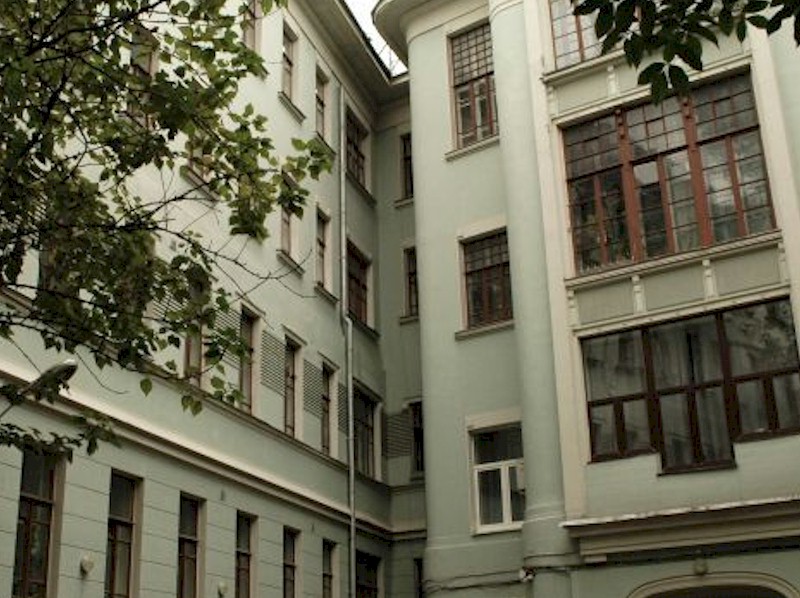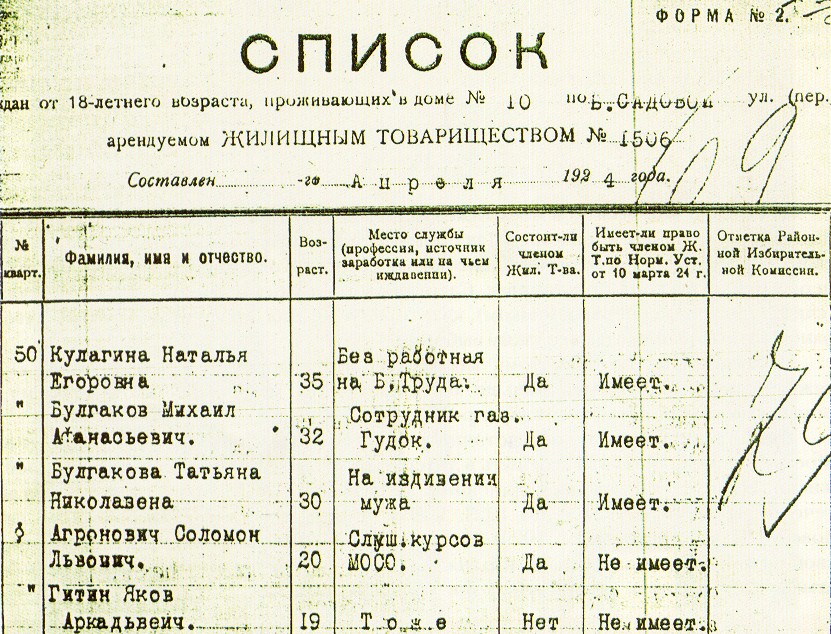Bolshaya Sadovaya
Woland and his retinue move in into Bolshaya Sadovaya ulitsa 302-bis, apartment number 50. This building plays an important role, not only in The Master and Margarita, but also in Bulgakov's personal life. In reality the house is on number 10. But Bulgakov loved it to make housenumbers or names of official institutions much more complicated to denounce the Soviet bureaucracy.
The Pigit building
The building was originally intended for luxury rental apartments and was built between 1902 and 1905 by order of the Russian millionaire Ilya Davidovich Pigit (1851-1915), owner of the tobacco company Ducat. The building was erected in the so-called Russian Art Nouveau style at a time when Moscow came into full bloom and many new avenues, lined with trees, were constructed. The Bolshaya Sadovaya ulitsa or Big Garden street was one of those avenues, and was part of the Garden Ring around the center of Moscow. In June 1917, just before the October Revolution, Ilya Pigit sold the building to a private real estate company. It was a good move, because after the revolution, the new Soviet regime claimed the house to transform it into one of the first communal apartments buildings in Moscow. In 1938, the building lost much of its original charm as the front fence was removed to make way for a broadening of the street.

Bolshaya Sadovaya no. 10
Bulgakov lived here in apartment number 50 with his first wife Tatiana Nikolaevna Lappa (1892-1982) from 1921 to 1924. In the summer of 1924 he succeeded to move to the much nicer apartment number 34 on the fifth floor, of which he also used some characteristics for its description of apartment number 50 in the novel. Tatiana Nikolaevna would understand only later that Bulgakov had arranged for this removal in order to ensure that she would not be left behind in an unpleasant environment, because only a few months later he would leave the building himself to move to the dwelling of Lyubov Evgenyeva Belozerskaya (1895-1987) with whom he would get married in April 1925. Once there was a café in the basement of this building, named Pegasus' Stables, in which the Russian poet Sergey Alexandrovich Yesenin (1895-1925) met his later wife, the American dancer Isadora Duncan (1877-1927).

Isadora Duncan and Sergey Yesenin
In The Master and Margarita Bulgakov describes the apartment number 50 as Нехорошая квартирка [Nekhoroshaya kvartirka] or The bad little flat. In the English editions it is translated as The Haunted Flat (Glenny) or The Evil Appartment (Pevear and Volokhonski).

Apartment no. 50 (top left)
In the novel Bulgakov describes a rather intelligent population in apartment number 50, like Berlioz and Styopa Likhodeev, but the reality was far less convenient. When he still lived in apartment number 50, Bulgakov described the house as «a nightmare where the rooms are horrible and the neighbours too». He writes about this building in more than one of his stories.
The residents
The Bulgakovs did not live alone in apartment number 50. It was a so-called коридорная система [korridornaya sistema] or corridor system. When you enter the apartment, you see a corridor with on both sides the doors of the rooms of the different inhabitants who would have one or two rooms, depending on the family size.

The tenants list in April 1924
Bulgakovs feelings about apartment number 50 are accurately described in a little rhyme which he added as a post scriptum in a letter to his sister Nadezhda (1893-1971) on October 23, 1921:
On Bolshaya Sadovaya street
Stands a great block of apartments
In the block live our brothers in evil:
The organized proletariat
And I was engulfed by the proletariat,
As if I was an atom (sorry for the comparison)
Our facilities are really lousy
Nothing works, like for instance our W...r Cl...t
The sink goes its own way too
Dry during the day, and at night it flows on to the floor
Left of me a woman's voice strikes upwith «Poor seagull»
And through my right wall they're playing the balalaika.
Site of pilgrimage and graffiti
Long before the existance of a Bulgakov museum in Moscow, this place became a site of pilgrimage for Bulgakov-fans, who embellished the stairwell leading to apartment number 50 with drawings and quotations from The Master and Margarita.
Manuscripts Don't Burn
In 1971, Yuri Lyubimov (1917-2014), the director of the Taganka Theatre in Moscow, managed to organise a theatre play based on The Master and Margarita. At the end of the spectacle the actors unfolded a banner with the slogan: Рукописи не горят [rukopisi ne goryat] or Manuscripts don't burn. Despite heavy critics in the party newspaper Pravda, the play remained at the theatre's repertoire until May 1984, when it was banned. Yuri Lyubimov got fired and he lost his Soviet citizenship. Since then the number of graffiti in Bulgakov’s house increased tremendously. Some graffiti demanded that the house would be transformed into a museum: «Make apartment number 50 a museum devoted to Woland and other pure forces». Apartment 50 was occupied by graphic artists working in a design office. They opened their doors for Bulgakov's admirors and the graffiti artists who got the permission to put their drawings, poems and other outporings on the walls. The graffiti rolled out from the stair well to the apartment. This was the first phase in the process of creating a space for the forgotten writer, and especially a spontaneous statement showing that he was still alive in many hearts.
An explanation of the graffiti is available in the Archives section of this website. You can download it with the arrow below.
Between 1984 and 1986 the building, the stair well and the apartment were subject of a struggle between officials, the house's caretaker and the graffiti artists. The graffiti were completely removed and whitewashed but «the scum» always came back to put new graffiti and new demands. More than once the caretaker changed the security code at the entrance, but it got hacked every time again. Eventually the officials gave up. In the spring of 1988 the city authorities gave the permission to start an official museum, but it would take much more time to get there.
There was indeed a huge difference between the aims of the activists and the expectations of the city authorities. The stair well and the apartments were totally devoted to the protagonists of The Master and Margarita. The activists wanted a museum dedicated to the novel and its context. The writer was present, but in the background. The city wanted a Bulgakov museum. The idea of a museum solely devoted to The Master and Margarita was too risky. Because it could become the source of voices that were not supposed to be heard.
Today most of the graffiti disappeared again. On December 22, 2006 there has been an incident in the house at Bolshaya Sadovaya 10. An ardent Bulgakov-fighter, Alexander Morozov, had daubed the graffiti with sprayers. It appeared to be impossible to remove the devastations without damaging the graffiti, so the stair well was again painted neaty in pallid green, while only few of the graffiti could be saved.

Bulgakov in the stair well
Soon we will add to this mobile version of our website a photo gallery showing how the stair well looked like before the vandalism
At the entrance of the building you can admire some life-size frescos. It are copies of illustrations made by Pavel Orinyansky, probably one of the most famous Russian illustrators of The Master and Margarita.
Museums
The building on Bolshaya Sadovaya no. 10 in Moscow houses two museums of which you can read more with the following link.
English subtitles
All films based on The Master and Margarita have been subtitled by your webmaster in English, French, Dutch, German, Spanish and Italian. Click on the link belw to find them.







